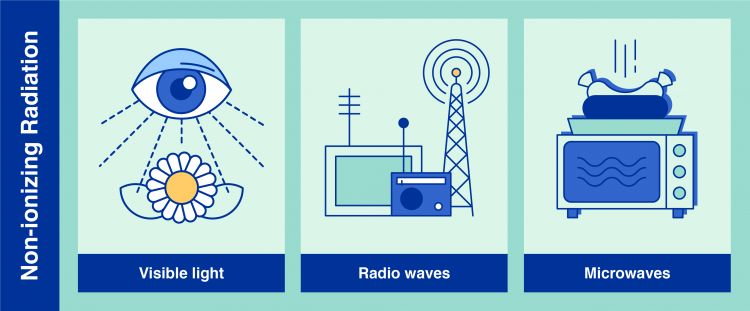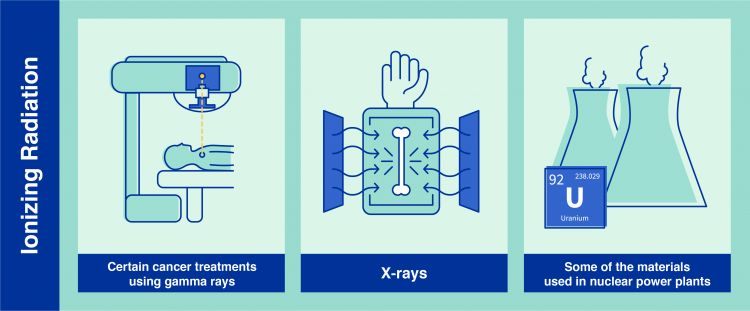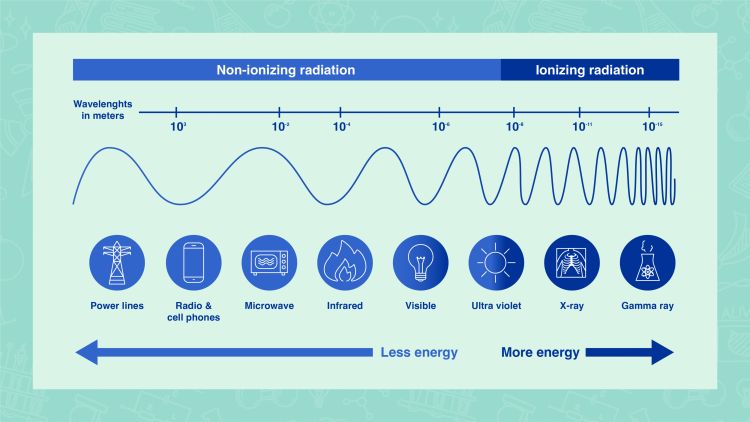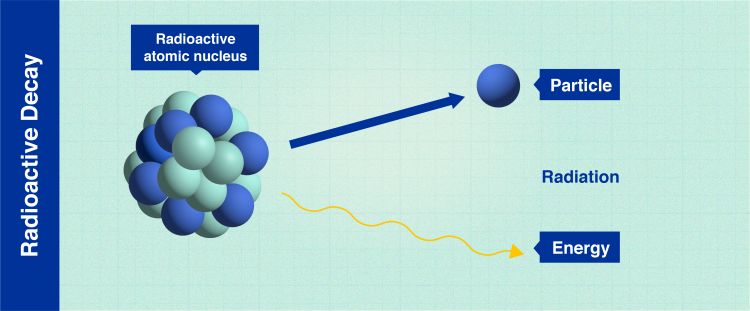Types of radiation Non-ionizing radiation

Some examples of non-ionizing radiation are the visible light, the radio waves, and the microwaves (Infographic: Adriana Vargas/IAEA)
Non-ionizing radiation is lower energy radiation that is not energetic enough to detach electrons from atoms or molecules, whether in matter or living organisms. However, its energy can make those molecules vibrate and so produce heat. This is, for instance, how microwave ovens work.
For most people, non-ionizing radiation does not pose a risk to their health. However, workers that are in regular contact with some sources of non-ionizing radiation may need special measures to protect themselves from, for example, the heat produced.
Some other examples of non-ionizing radiation include the radio waves and visible light. The visible light is a type of non-ionizing radiation that the human eye can perceive. And the radio waves are a type of non-ionizing radiation that is invisible to our eyes and other senses, but that can be decoded by traditional radios.
Ionizing radiation

Some examples of ionizing radiation include some types of cancer treatments using gamma rays, the X-rays, and the radiation emitted from radioactive materials used in nuclear power plants (Infographic: Adriana Vargas/IAEA)
Ionizing radiation is a type of radiation of such energy that it can detach electrons from atoms or molecules, which causes changes at the atomic level when interacting with matter including living organisms. Such changes usually involve the production of ions (electrically charged atoms or molecules) – hence the term “ionizing” radiation.
In high doses, ionizing radiation can damage cells or organs in our bodies or even cause death. In the correct uses and doses and with the necessary protective measures, this kind of radiation has many beneficial uses, such as in energy production, in industry, in research and in medical diagnostics and treatment of various diseases, such as cancer. While regulation of use of sources of radiation and radiation protection are national responsibility, the IAEA provides support to lawmakers and regulators through a comprehensive system of international safety standards aiming to protect workers and patients as well as members of the public and the environment from the potential harmful effects of ionizing radiation.

Non-ionizing and ionizing radiation have different wavelength, which directly relate to its energy. (Infographic: Adriana Vargas/IAEA).
The science behind radioactive decay and the resulting radiation

The process by which a radioactive atom becomes more stable by releasing particles and energy is called “radioactive decay”. (Infographic: Adriana Vargas/IAEA)
Ionizing radiation can originate from, for example, unstable (radioactive) atoms as they are transitioning into a more stable state while releasing energy.
Most atoms on Earth are stable, mainly thanks to an equilibrated and stable composition of particles (neutrons and protons) in their centre (or nucleus). However, in some types of unstable atoms, the composition of the number of protons and neutrons in their nucleus does not allow them to hold those particles together. Such unstable atoms are called “radioactive atoms”. When radioactive atoms decay, they release energy in the form of ionizing radiation (for example alpha particles, beta particles, gamma rays or neutrons), which, when safely harnessed and used, can produce various benefits.
Post time: Nov-11-2022

